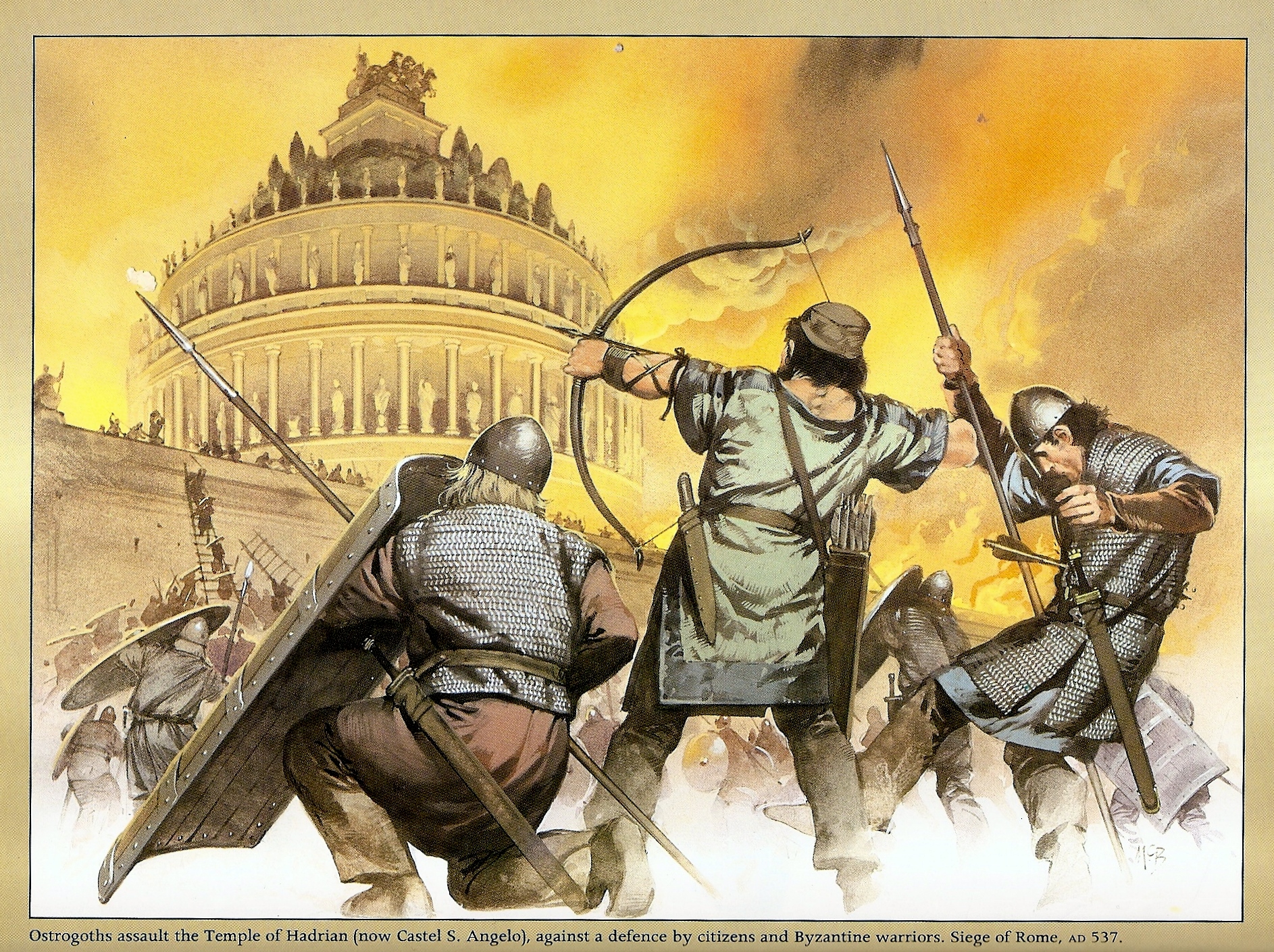Just as in battlefield tactics, military organization and logistical capabilities, Ostrogothic siege warfare differed little from East Roman practices. They regularly constructed siege camps or full-scale siegeworks to hem in the besieged, and were also adept at other sorts of field fortification, such as the fortified bridge mounted with ballistae that they constructed near Vesuvius at the end of the war. Despite many comments on the late or rare appearance of Ostrogothic artillery during these wars, it is possible to argue that the Ostrogoths had defensive artillery from the outset, where the Ostrogothic defensive barrages during the siege of Osimo in 539 seem to indicate as much. However, secure identification is obscured by Procopius’ writing style and emphasis. Furthermore, the Ostrogoths had a formidable arsenal of offensive siege engines that have not yet been taken seriously. Artillery was in fact rarely used (or at least hardly ever described) in offensive siege operations during the early 6th century, so engineering capabilities must be evaluated on the basis of other machines. During the first assault of Rome (537), at the northern Salarian gate sector, they brought up four powerful rams, which Procopius described in great detail, noting that they were very destructive. In addition the Goths had built large moving towers that terrified the civilian defenders. Procopius relates how Belisarius dismissed the assault with a laugh, since they were using oxen to haul the towers forward. Many scholars have taken this anecdote as proof of barbarian ineptitude, or at least as a classicizing topos on the same, but a close reading of the text reveals that there is more to these events. The Ostrogoths were in fact well prepared and knew what they were doing.
Elsewhere Procopius describes how the Ostrogoths had large shields that made them impervious to regular archery fire. When they assaulted Hadrian’s mausoleum, they could take cover under the colonnade of St. Peter’s to get so close that the defenders were unable to operate the ballistae against them. The angle was too steep and the range too short to use machines, which only left the use of bows. When archery failed against their large shields and the Goths were about to scale the wall with ladders, the defenders survived by breaking up the statues on the mausoleum and dropping them onto the heads of the Goths.
The effectiveness of their shields makes the Gothic approach with oxen more comprehensible. The oxen were protected by serried ranks of armored infantry: “Belisarius, seeing the enemies’ formation marching slowly with the machines (…).” Instead of expending fire on well-prepared infantry marching slowly in formation and protected by large shields, Belisarius deliberately let them get close to the moat. He then built up the confidence of his troops with two well-aimed bowshots that took down two of the armored leaders of the formation, to roars of approval from the defenders. Only “then did Belisarius signal to the whole army to set in motion all the archery, but those around him he ordered to shoot at the oxen only.”

From this it is clear that the strategy was planned out beforehand, since simultaneous firing began from the whole wall on a given signal. While Procopius uses the generic toxeumata (archery), bows alone would have been insufficient to break up the Gothic formations. From Procopius’ description of the ballista, however, where he compares it to a large bow, it is possible that his use of toxeumata included the ballistae, which could wreak havoc on the infantry protecting the oxen. This was what Belisarius was waiting for; he personally led those who were to fire on the oxen, taking advantage of the gaps and chaos caused momentarily by massive archery and ballista fire against the infantry. The oxen fell “immediately” when the whole operation was set in motion. At that point the Goths gave up an outright storm at that sector, but kept up pressure with continuous archery fire against the parapets. Meanwhile assaults took place at Hadrian’s mausoleum to the west, mentioned above, and Vivarium to the east. Here the “machines,” which possibly included towers and certainly rams, worked as planned, and the defenders were terrified by the Gothic assault before Belisarius arrived with substantial reinforcements. The Goths assaulted with machines along a large sector, and were able to reach the outer wall of the Vivarium, which was less heavily fortified than other parts of the wall. They put their rams to good use, breaking through the wall, but here Belisarius kept his cool, holding the reinforcements in reserve at the gates. He ordered one group to hold up those who had broken through the wall, while he himself led a sally out the gates that caught the Goths outside by surprise. At the same time, a sally at the Salernian gate drove off the Goths at that sector as well. Most of the Gothic siege engines were burnt that night. It had been a close call on two of three sectors, only warded off by quick thinking, good leadership and an extremely well-equipped and highly motivated expeditionary army. A similar deployment of a large siege tower at Rimini (II, 538) has also been used to dismiss Gothic engineering capabilities, but again, a close reading of the text makes it clear that the Goths actually handled the engine well and adapted to circumstances. Furthermore, Gothic approaches were similar to that used by the Romans at Amida, and while military means were ultimately fruitless, they won Rome by treason after hard fighting, and took a host of Roman cities by surrender or storm.